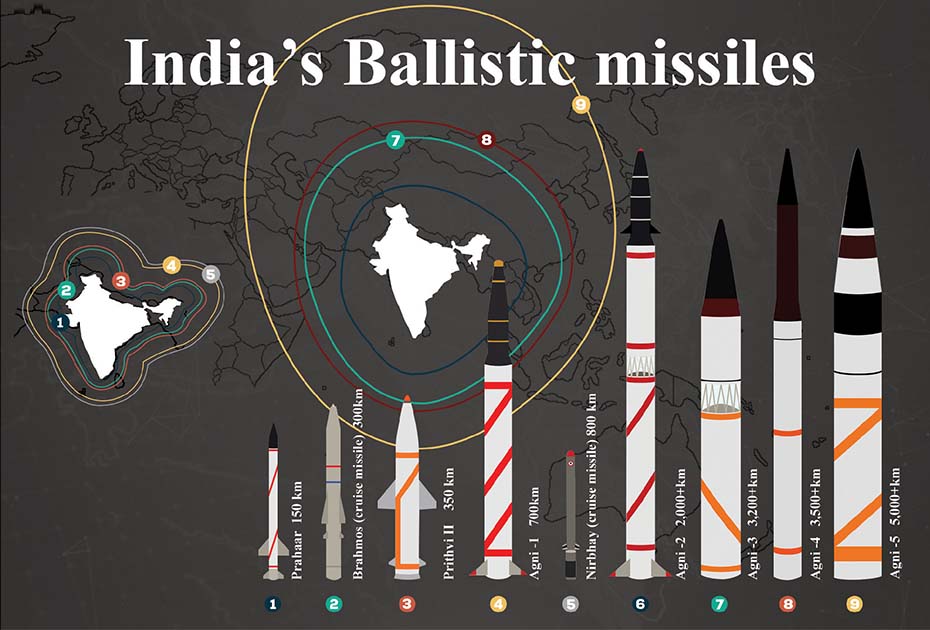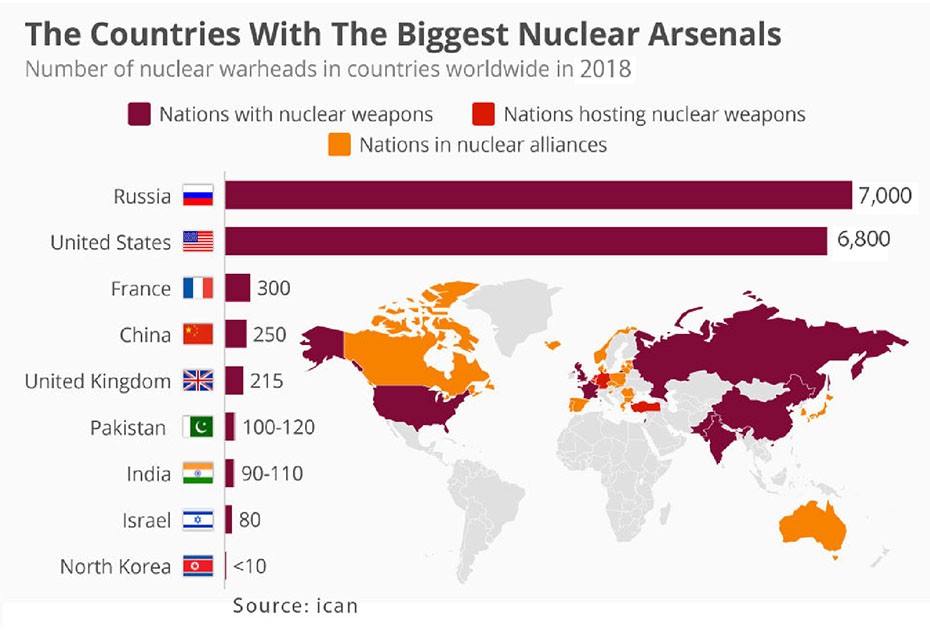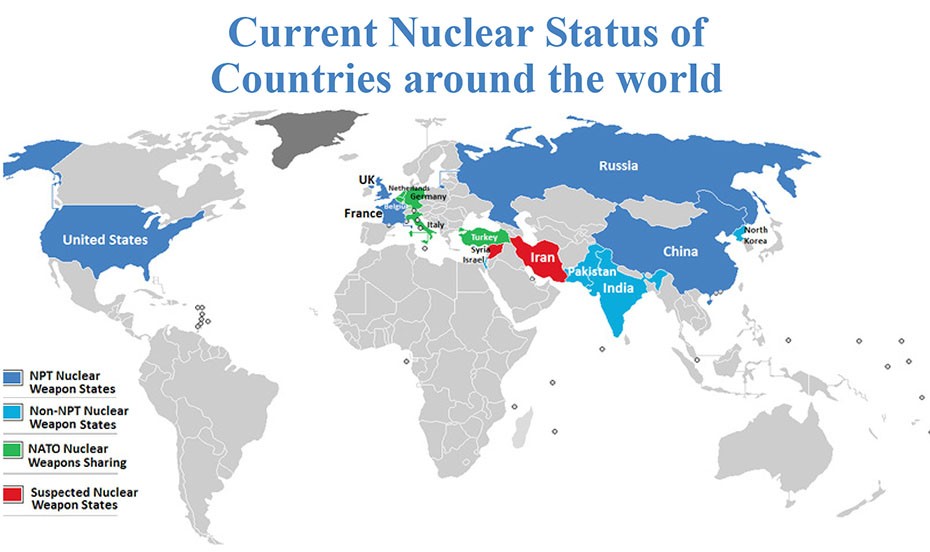India demonstrated its nuclear prowess, for the first time, in May 1974, though it chose to call that nuclear explosive test a ‘Peaceful Nuclear Explosion’ (PNE). This characterization served to alleviate international pressure and sanctions, and provided a convenient smoke screen for the global powers to react mildly to this development.
The other reason for India to not declare itself as a nuclear weapons power in 1974, was the fact that it did not possess requisite nuclear delivery systems, except a few WW-II vintage Canberra bombers. It also did not have the wherewithal to establish an effective and operationally viable nuclear command and control structure.
It, therefore, feared that if it prematurely declared its nuclear status, it might be subjected to a pre-emptive Chinese strike. India’s focus, then, shifted to greater investments in its space and missile programs.
It initiated, in 1983, an Integrated Guided Missile Development Program (IGMDP) aimed at producing an anti-tank missile Nag, a short range surface to air missile Trishul, a medium range surface to air missile Aakash and, most importantly, a short-range nuclear-capable ballistic missile Prithvi as well as a medium range nuclear capable ballistic missile Agni.
The Indians had rightly anticipated that any sanctions imposed on India would be short-lived and in the long run, its international stature would improve substantially. The developments in the past two decades have proven them right.
India later added a Cruise missile BrahMos (a joint Russian-Indian venture) and longer range versions of Agni series of missiles with Agni five approaching the ICBM range. It has also tested Submarine Launched Ballistic Missiles and has been experimenting with a Ballistic Missile Defense (BMD) program, for over a decade now.
Once space and missile capabilities started to mature, India felt confident enough to bring its nuclear weapons capability out of the closet. During Narasimha Rao’s premiership, India had planned to conduct another nuclear test which, was scheduled in December 1995. However, the preparations, for the test, were picked up by American satellites and the Rao government had to abandon the test under US pressure.
Then in the spring of 1996, during his short stint in Prime Minister’s office, lasting 15 days, Vajpayee had instructed Abdul Kalam and Chidambram to go ahead with the nuclear tests but that plan had to be abandoned due to his failure to win the vote of confidence for his government in the parliament. Even I.K.Gujral, commonly perceived as a pacifist, had also toyed with the idea of a nuclear test to boost his political fortunes.
Read more: A glimpse of the past: Was Pakistan ready to respond to…
India declares itself a Nuclear Power
In February 1998, on the eve of the national elections in India, the BJP had unambiguously declared in its election manifesto that, on coming to power, it will test and induct nuclear weapons. The outside observers either dismissed it as election rhetoric or expected that such a precipitate decision would only be taken after a review of national security has been completed by the proposed National Security Council after the elections.
However, one of the first directives issued by Prime Minister Vajpayee, was to ask his scientists to start preparations for nuclear tests. After just over a month of coming to power, the BJP made good on its election promise and conducted three nuclear tests on 11th of May 1998, including a claimed ‘thermonuclear’ test.
They went on to conduct another two ostensibly low yield tests on 13th of May 1998. It was obvious that India wanted to showcase its thermonuclear capability as well as more advanced fission bomb designs, to enhance its status as a technologically advanced and powerful country which, was poised to play a major role at the international stage.
Once space and missile capabilities started to mature, India felt confident enough to bring its nuclear weapons capability out of the closet. During Narasimha Rao’s premiership, India had planned to conduct another nuclear test which, was scheduled in December 1995.
This time, however, there was no pretension of ‘peacefulness’ and the Indian Prime Minister declared India a nuclear weapons power, arguing that it was India’s legitimate right since it constitutes one-sixth of humanity.
In his letter to President Clinton, justifying India’s action, the Indian premier found convenient scapegoats in Pakistan and China, stressing that India’s security environment had greatly deteriorated due to two nuclear-armed countries in its neighbourhood, alleging surreptitious cooperation between the two.

After the Indian tests, the mandatory sanctions under the 1994 Nuclear Proliferation Prevention Act, also known as the Glenn Amendment, were automatically triggered but the international reaction, especially of the French and the Russians who refused to be part of any sanctions regime against India, remained ambivalent.
The EU and G-8 were also opposed to any sanctions against India. The Indians had rightly anticipated that any sanctions imposed on India would be short-lived and in the long run, its international stature would improve substantially. The developments in the past two decades have proven them right.
Read more: Can Americans seize Pakistan’s nuclear bomb?
Pakistan declares itself Nuclear
There was a certain body of opinion in India which, believed that Pakistan’s nuclear program was a bluff, created in connivance with the West, to constrain India’s nuclear options. They thought it is a good opportunity to call Pakistan’s bluff. If Pakistan failed to demonstrate its nuclear weapons capability, it would forever be discredited.
There were others who wanted to provoke Pakistan into responding to Indian tests, with the short term objective of deflecting and dissipating international opprobrium being faced by India and bring Pakistan in the dock as well.
Pakistan waited for the international community to put its act together but having seen the feeble response of the major powers and endured open threats by the Indian leadership, Pakistan had no option but to showcase its own nuclear capability and restore the strategic balance that had been destabilized by the Indian tests.
This was also a golden opportunity for Pakistan to demonstrate its nuclear deterrent capability which, would not come its way again. Pakistan, therefore, conducted five tests on 28th of May, in tunnels constructed in the Chaghai hills in Balochistan decades ago. A sixth test was conducted at Kharan on 30th of May 1998.
Nuclear South Asia has grown from teens to twenties and, the nuclear management structures as well as the doctrinal precepts, have also evolved through many serious crisis from Kargil to the 2001-02 military stand-off to the Mumbai crisis of 2008.
Much has been written about Pakistan attempting to be one up by conducting six tests to India’s five which, is a rather simplistic view of the situation. Pakistan knew that it may well be the first and last opportunity to conduct full scale nuclear explosive tests. It, therefore, had to make the best use of the opportunity.
However, it was dependent on the availability of a requisite number of tunnels, a variety of devices of different designs and availability of sufficient amount of fissile material. If the required number of tunnels were not available, it wouldn’t have possible to prepare these at short notice.

Similarly, if a variety of designs were not available, it would have been futile to test the same design many times which, would have meant wastage of scarce and costly fissile material. So it was not settling of scores but achieving own technological objectives. The Indian rhetoric immediately calmed down as it realized that strategic balance has been restored by Pakistan.
Consequently, Vajpayee undertook the bus journey to Lahore and the Lahore Declaration and the Lahore Memorandum of Understanding, emanating from this summit meeting was the first attempt to bring some order to the nuclear rivalry in South Asia. However, the process was disrupted by the onset of the Kargil conflict.
Read more: Is ‘Full Spectrum Deterrence’ an effective nuclear policy for Pakistan?
Kargil: Start of New South Asian Dynamics
For India, Kargil came as a shock and embarrassment for various reasons. Firstly, it viewed it as a betrayal of the bonhomie developed at Lahore. Secondly, it was an embarrassing failure on part of its intelligence agencies and the Indian military, who were unable to detect the incursion into Kargil area for months.
Thirdly, it had to pay a very high price in terms of casualties, in trying to recover the lost territory and, had it not been for President Clinton’s intervention to persuade Pakistan to withdraw from the occupied territory, the cost could have been even higher. It also came at an inopportune political moment, when Vajpayee government had lost a vote of confidence in the parliament and was facing fresh elections.
Two decades have passed since the overt nuclearization of South Asia but the two South Asian antagonists have failed to establish an overarching regime to maintain degree of sanity in the nuclear competition in the region.
The Indian government had to react as strongly and violently as it could to save its face before its electorate. Pakistan, having been stung by the adverse international reaction to the Kargil conflict, decided to keep a low profile with regard to its nuclear development and operationalization plans and held back the public pronouncement of its nuclear doctrine.
It also recognized the fact that a certain degree of ambiguity adds to the value of deterrence by keeping the other side guessing, although striking the right balance between ambiguity and transparency is always a delicate act. Nuclear South Asia has grown from teens to twenties and, the nuclear management structures as well as the doctrinal precepts, have also evolved through many serious crisis from Kargil to the 2001-02 military stand-off to the Mumbai crisis of 2008.

One of the main strategic objectives of Pakistan’s nuclear capability is to deter aggression at any level of conflict. It, therefore, has not only to deter the nuclear threat from India but also to ward off its superior conventional capability as well. Pakistani nuclear doctrine, therefore, remains sensitive to changes not only in India’s nuclear doctrine but also its conventional doctrine.
When India embraced the Cold Start Doctrine and challenged the credibility of Pakistan’s nuclear deterrence, Pakistan responded by introducing battlefield nuclear weapons to raise the perceived cost of any misadventure by India, by deliberately lowering its nuclear threshold and effectively closing any space that India may have been eyeing for exploitation.
Read more: Pakistan’s nuclear plants are heavily protected: IAEA Chief
Next Steps in Strategic Partnership (NSSP)
In 2005, the U.S. took a policy decision to enhance its strategic partnership with President Bush and PM Manmohan Singh outlining a roadmap named the Next Steps in Strategic Partnership (NSSP). This included cooperation in defense, space and nuclear technology leading to the formalization of US-India Civilian Nuclear Cooperation Agreement. The U.S. invested its political capital to secure a special NSG waiver for India, thereby opening the doors of international nuclear commerce for India.
President Obama explicitly committed himself to facilitate India’s entry into the four components of the international export control regime, namely the MTCR, the Australia Group, the Wassenaar arrangement and the NSG.
Whereas India has already secured its berths in three of these, it is trying to gain its formal entry into the NSG which, is currently held up due to Chinese objections to exceptionalism and insistence on development of uniform criteria for the entry of all non-NPT nuclear states. Pakistan also applied for the membership of NSG but will have to wait until an agreement on the membership criteria is reached amongst the NSG members.

India, however, due to its special waiver, is enjoying all the privileges of an NSG member, less of having a voice in its policymaking. Some circles have made much of the recent placing of three private Pakistani companies on the US Department of Commerce Entity List, as a move to complicate Pakistan’s case for entering the NSG.
This list includes hundreds of companies from around the world and has, in the past, consisted of Indian entities, including those related to its nuclear and space programs. Moreover, two Indian scientists were also included in the list for sharing their expertise with the Iranians. Key Pakistani entities, such as SUPARCO, have been on the list and KRL was subjected to MTCR related sanctions.
U.S. is clearly trying to enhance India’s strategic position since it views India as a strategic counterweight to checkmate China’s rise. Consequently, India was viewed as an important partner in the implementation of Obama’s Pivot to Asia-Pacific. It is also a member of the Quad, created by the Trump administration and includes the US, Japan and Australia to counter growing Chinese influence in the Pacific region.
Read more: Babur-III tested; Pakistan becomes a Nuclear Triad
Two decades have passed since the overt nuclearization of South Asia but the two South Asian antagonists have failed to establish an overarching regime to maintain degree of sanity in the nuclear competition in the region. Pakistan had proposed a Comprehensive Restraint Regime, based on nuclear restraint, along with conventional balance and resolution of disputes, from as far back as October 1998, and had renewed its offer when the Comprehensive Dialogue resumed in 2004 and in later rounds of talks as well.
India, however, has not shown any interest in discussing this proposal, nor has it come up with a matching proposal of its own. Meanwhile, newer threats are emerging, especially in the cyber domain which, need to be considered seriously as and when the dialogue process is resumed, though it is nowhere in sight at the moment due to India’s declared policy of isolating Pakistan and the aggressive posture adopted by the Modi government towards Pakistan. One could only hope that sanity would prevail before some catastrophe hits the hapless millions inhabiting this part of the world.
Dr. Naeem Salik is Senior Fellow at the Center for International Strategic Studies (CISS). He served in the Pakistan Army in a variety of assignments including tenure as Director Arms Control and Disarmament Affairs at the Strategic Plans Division. His books on the subject of the Nuclearization of South Asia include Learning to Live with The Bomb – Pakistan 1998-2016 and ‘Genesis of South Asian Nuclear Deterrence’. His Ph.D. is in Political Science and International Relations from the University of Western Australia. He holds a Master in International Politics and Strategic Studies from the University of Wales, UK and a Master in History from the Punjab University.
The views expressed in this article are the author’s own and do not necessarily reflect the editorial policy of Global Village Space.


